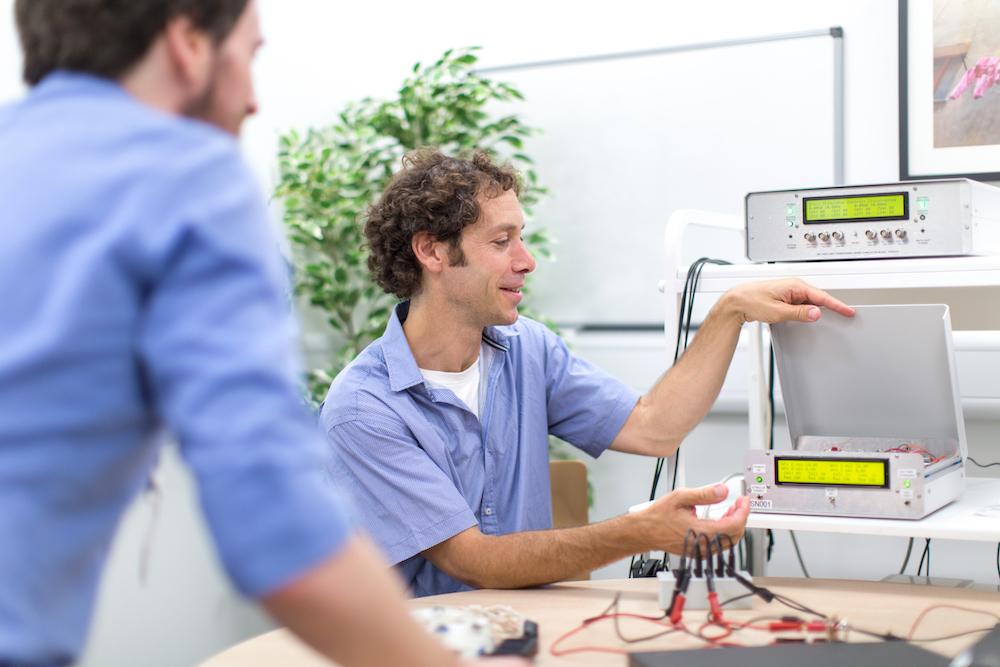A team led by UK DRI Group Leader at Imperial, Dr Nir Grossman, has discovered a way of suppressing aberrant synchronous oscillations in the brain, which cause the tremors associated with some brain disorders.
Synchronous oscillations in the brain have a number of important functions, including regulating states such as attention and vigilance. However, when these oscillations go wrong, they cause some of the symptoms seen in a range of neurological disorders. Aberrant oscillations in the motor regions of the brain can cause pathological tremor movement. These tremors are most commonly associated with Parkinson’s disease, which affects around 145,000 people in the UK, but the same tremors can affect people with a number of other more common conditions, such as Essential Tremor Syndrome. The aberrant synchronous oscillations that cause such tremors are also sometimes seen in people with Alzheimer’s disease, where they result in impaired vigilance and cognition.
Tremors cause people’s hands, head, legs or other body parts to shake, and can be severely disabling. The underlying cause of the aberrant oscillations is still largely unknown, making it difficult to treat symptoms with drugs. In severe cases, brain surgery may be an option, but this is invasive, not widely available and carries risks.
Tremor symptoms can be upsetting and get in the way of doing basic, everyday things that most of us take for granted. In the worst cases, they can be severely debilitating.Dr Nir GrossmanGroup Leader from UK DRI at Imperial
In this study, published today (13 January 2021) in the journal Nature Communications, researchers developed a means of calculating and tracking the phase of oscillatory signals from the brain in real time. They then used a non-invasive form of electrical stimulation to target the cerebellum, an area of the brain that controls muscle coordination. They found that by ‘phase-locking’ the electrical stimulation to the aberrant oscillation, they were able to lessen tremors in people with Essential Tremor Syndrome, the most common neurological disorder to cause such tremors.
Electrical stimulation was given to 11 people with Essential Tremor Syndrome by applying electrodes to the scalp, arranged to maximise the electric fields in the cerebellum. The electric fields were adjusted in real time to maintain a fixed phase corresponding to the ongoing tremor movement. The reduction of symptoms lasted during stimulation and for a short period afterwards. The team found that the reduction in the tremor amplitude was associated with a disruption of the regularity of the movement: the more the stimulation made the tremor irregular, the more it reduced its amplitude.
The team hopes that this discovery will pave the way for possible long-term treatment of tremors and other symptoms in people with brain conditions that involve aberrant synchronous oscillations.
people with Essential Tremor Syndrome were given electrical stimulation by applying electrodes to the scalp

demonstrates technology used to apply non-invasive electrical brain stimulation
Dr Nir Grossman, Group Leader from UK DRI at Imperial, commented:
“Tremors are caused by abnormal synchronisation in the motor areas of the brain but the biological processes underlying them are still not well understood. By targeting the temporal pattern of the brain’s abnormal synchronisation, we may be able to treat it, non-invasively, despite the limited knowledge of the precise causes.
“Our work presents an early-stage feasibility study of this approach. We hope to continue to develop it into a widely available treatment for tremors, as well as other symptoms that are underpinned by abnormal synchronisation in the brain.”
Reference
Article published: 13 January 2021
Image credits: Thomas Angus, Imperial College London
In these images Dr Nir Grossman demonstrates his brain stimulation work with Ryan 0'Hare from Research Communications at Imperial College London.
